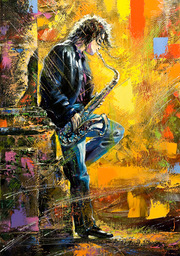What to Know About Art Styles When Teaching Kids
As an educator, art is an important subject to teach children. Not only does it allow them to express their creativity, but it also helps develop critical thinking, fine motor skills, and emotional skills. When teaching art to kids, it’s helpful to expose them to a variety of art styles and movements.
This allows them to understand how art has evolved over time and appreciate different techniques and perspectives.
Here’s an overview of some key art styles and tips for how to incorporate them into your lessons.
Impressionism
Impressionism emerged in the late 1800s in France as artists like Monet, Renoir, and Degas moved away from precise realism towards a more expressive style. The hallmarks of impressionist painting include visible brushstrokes, open composition, emphasis on light, and everyday subject matter like landscapes and scenes of daily life.
When teaching impressionism, focus on having students paint what they see using thick, visible brushstrokes and vibrant colours. Set up still-life scenes or have them paint outdoors. Encourage them to convey a fleeting moment in time and pay attention to the effects of light. Point out how the paintings have an open composition and blurred edges compared to more realistic styles.
Cubism
Developed by Picasso and Braque in the early 20th century, Cubism radically distorted traditional perspective and form. Cubist paintings reduce subjects into geometric shapes and planes, depicting them from multiple angles at once. The style marked a major shift towards abstraction in modern art. Cubism demonstrated a stark contrast in art with its fragmented, multi-view interpretations compared to previous styles.
When introducing Cubism, show paintings by Picasso like Les Demoiselles d’Avignon to demonstrate the fragmented planes and faceting of forms. Have students break down objects into basic shapes and form a collage by layering and overlapping them from different viewpoints. Encourage them to use a limited colour palette of neutrals and earth tones. Focus on analysing shape and structure rather than realistically portraying the subject.
Pop Art
Emerging in the 1950s, Pop Art injected art with irony, fun, and imagery from mass media and commercial products. Artists like Andy Warhol and Roy Lichtenstein popularised the style through silkscreened paintings and cartoons influenced by advertising and comic books.
When teaching about Pop Art, focus on bold colours, repetition, and recognisable consumer imagery. Encourage students to create pieces inspired by iconic styles, incorporating elements like repetition and vibrant hues. An engaging way to illustrate Pop Art’s impact on interior design is through 3 piece wall art sets. These compositions often feature bold, vibrant visuals reminiscent of the Pop Art era, allowing students to explore how this art form translates into modern décor while still embracing its playful and dynamic essence.
Abstract Art
Abstract art does not portray recognisable objects; instead, it uses colour, shape, and texture for their own visual interest. It communicates emotions and ideas in a non-representational way. From the flowing compositions of Kandinsky to the monochromes of Rothko, abstract art covers a wide range of styles.
When introducing abstract art, encourage students to focus on elements like line, colour, and composition without aiming to depict specific objects or scenes. Demonstrate techniques like dripping, sponging, and printing to build textures. Have them experiment with mixing paint colours directly on the paper and combining bright hues with black and white. Emphasise personal expression and getting a feel for the paints and materials.
Surrealism
Emerging between the world wars, Surrealism aimed to tap into the unconscious mind to unveil the world of dreams and imagination. With visually jarring juxtapositions and irrational combinations, Surrealist artists like Dali, Magritte, and Ernst created scenes that defy logic.
When teaching about Surrealism, encourage students to let their imagination run wild. Have them create collages combining unrelated items like fish, clocks, and umbrellas set against unusual backgrounds. They can make exquisite corpse drawings by folding paper and creating composite figures. Demonstrate techniques like frottage (rubbing) and decalcomania (transferring paint patterns) to achieve unexpected textures. Emphasise the element of surprise and sparking the viewer’s imagination. Discuss how Surrealism impacts media like advertising and fiction today.
Portraiture
Portraiture has been an important genre throughout art history, capturing the likeness and personality of subjects. Portrait styles have evolved from formal busts and royal paintings to Impressionist snapshots and modern conceptual portrayals. Key elements include composition, facial expression, props, and settings to convey the sitter’s essence.
When teaching portraiture, provide a range of examples from classical to contemporary. Have students study the face proportions and map out facial features before adding colour and detail. Demonstrate techniques like contour line drawing to focus on shape and expression. Encourage experimenting with perspective, cropping, and backgrounds to create narrative and interest around the subject. Have them paint self-portraits and portraits of each other to practice observing and representing personality through art. Emphasise portraiture as a timeless way to honour subjects creatively.
Folk Art
Folk art encompasses a wide range of predominantly rural and homemade crafts like quilting, pottery, and traditional painting. Often passed down through generations and reflecting cultural heritage, folk artists tend to have little formal training. While the techniques are simple, the works contain charm and tradition.
When exploring folk art with students, present works from different cultures like Pennsylvanian Dutch Fraktur, Haitian sequin flags, or Oaxacan wood carvings. Have them create folk art inspired crafts using basic materials like coloured paper, glue, yarn, and natural objects. Emphasise learning from mentors and community traditions more than formal techniques. Discuss how folk art connects to cultural history and storytelling.
Animation
Animation is a dynamic form of modern art that combines technology, storytelling, and visual creativity to produce compelling and imaginative works. Unlike traditional static art forms, animation brings characters and worlds to life through movement and time, often conveying complex emotions and narratives. This art form has evolved significantly with advancements in digital tools and techniques, allowing artists to explore diverse visual styles and push the boundaries of creativity. Some popular styles of animation include traditional hand-drawn animation, 3D computer-generated imagery (CGI), stop-motion animation, and 2D digital animation, each offering unique aesthetic qualities and storytelling possibilities.
On the other hand, drawing is as a static art form. It captures a single moment, conveying emotion, detail, and story within a single frame. It relies heavily on the artist’s ability to encapsulate an entire narrative or feeling in one image or character. In contrast, animation extends drawing into the realm of movement and time, creating a sequence of images that together tell a story dynamically. While drawing focuses on capturing and conveying an idea within a still frame, animation leverages multiple drawings to create a living, evolving experience.
Tips for the Classroom
- Expose students to a diverse range of styles to build their understanding and appreciation of art. Provide art books and visits to museums or galleries.
- Combine art history lessons with hands-on creating activities to reinforce learning through experience.
- Accept all interpretations when discussing abstract art, focusing on how it makes the viewer feel.
- Allow plenty of time for experimentation and play as students develop skills.
- Display finished pieces around the classroom to build pride and allow learning from peers.
- Focus on the process rather than the outcome. Praise effort and creative thinking.
- Have students create black-and-white drawings to teach contrast in art, emphasizing how light shapes on dark backgrounds (and vice versa) enhance depth and visual impact.
- Introduce language to discuss art like hue, shade, texture, composition, and perspective. Painting by numbers can be a great way for kids to get excited about how to create their own art.
- Be enthusiastic about art to model passion for the subject. Creativity is enriching at all ages.
By tailoring lessons to focus on the key features of each major style, you can give students a well-rounded introduction to the wonderful world of art. They will gain knowledge of important movements while developing their own skills and creative confidence. Exposure to diverse techniques also teaches flexible thinking and open-mindedness. Most importantly, nurture their natural artistic curiosity and celebrate their self-expression. With some guidance on art styles and a supportive environment, their creativity will flourish.




